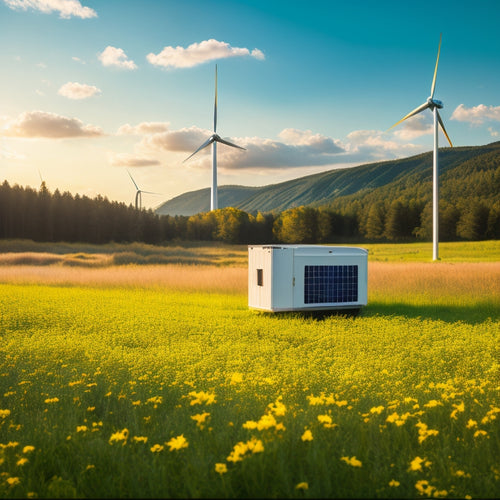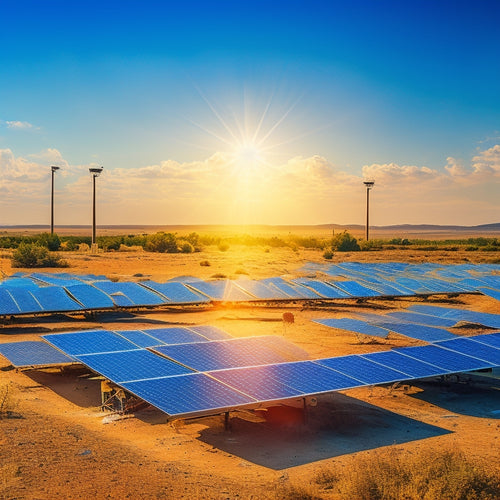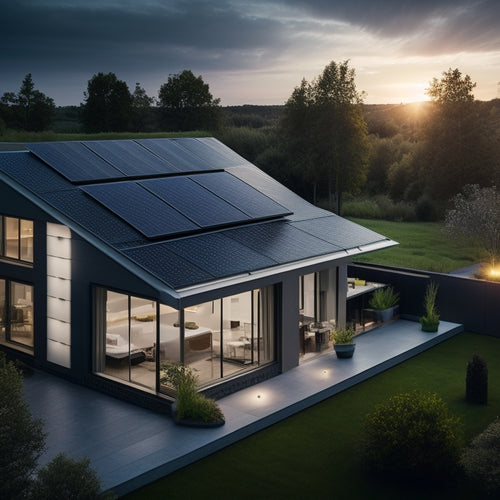
Why Home Energy Storage Fails: Troubleshooting Guide
Share
You're likely to experience home energy storage system failures if you don't address common pitfalls, such as neglecting battery maintenance, incorrect installation, inadequate system sizing, and monitoring errors. These mistakes can lead to a staggering 70% of systems underperforming or failing prematurely. You might overlook vital safety precautions, misconfigure your system, or ignore environmental factors like temperature and humidity, which can greatly impact performance. To guarantee maximum function, you'll need to identify and resolve these issues. By understanding the common causes of failure, you can take the first step towards diagnosing and fixing your home energy storage system's problems, and access its full potential.
Overview
- Neglecting battery maintenance, such as controlling charging frequency and temperature, reduces lifespan and efficiency.
- Installation and configuration problems, like faulty wiring and improper grounding, can cause overheating and electrical shorts.
- Inadequate system sizing due to incorrect load calculations and inaccurate energy usage data leads to reduced performance and lifespan.
- Environmental factors, including temperature extremes and high humidity levels, can impact battery efficiency and system performance.
- Regular monitoring and maintenance practices, including data verification and physical inspections, are essential for optimal function and troubleshooting.
Common Causes of Failure
Failing to identify and address common causes of failure can lead to inefficient or inoperable home energy storage systems.
You'll want to investigate the root causes of issues to prevent premature battery lifespan reduction and guarantee ideal performance. Neglecting battery maintenance, such as regular water level checks, can greatly reduce battery lifespan and efficiency.
One common mistake is ignoring system upgrades, which can lead to compatibility problems and reduced efficiency. You should also check for faulty wiring, improper installation, and inadequate ventilation, as these can cause overheating, electrical shorts, and system crashes.
Additionally, software glitches and outdated firmware can disrupt charging and discharging cycles, leading to reduced energy storage capacity.
Battery Maintenance Mistakes
Battery maintenance oversight is a vital pitfall that can greatly diminish your home energy storage system's performance and lifespan. You must stick to a rigorous maintenance schedule to guarantee ideal performance.
Failure to control charging frequency, temperature, and discharge cycles can notably reduce your battery's lifespan. Additionally, neglecting cleaning techniques and connection integrity can lead to premature failure.
Regular battery monitoring and maintenance is essential to prevent overcharging and undercharging, and setting a discharge limit can extend solar battery lifespan. It's important to monitor your usage patterns and adjust your storage environment accordingly.
Don't overlook safety precautions, such as keeping the area well-ventilated and avoiding physical damage. By prioritizing maintenance, you'll extend your battery's lifespan and guarantee a reliable energy supply.
Regularly inspect your system, and address any issues promptly to avoid costly repairs and downtime.
Incorrect Installation Diagnosis
During the setup process, ensuring that your home energy storage system is correctly installed is essential. Incorrect connections and configurations can lead to inefficient performance, safety hazards, and even complete system failure.
You must follow the manufacturer's installation guidelines to avoid common mistakes. A professional assessment can help identify potential issues before they become major problems.
| Common Installation Errors | Consequences |
| Inadequate grounding | Electrical shock, fire hazards |
| Incorrect battery configuration | Reduced system performance, shortened lifespan |
| Insufficient ventilation | Overheating, system failure |
| Improper wiring | Electrical shock, fire hazards |
| Failure to secure components | Physical damage, system failure |
Inadequate System Sizing Issues
When you're experiencing issues with your home energy storage system, it's crucial to check if the system was sized correctly in the first place.
You'll need to review the load calculation to verify it accurately reflects your energy needs, considering factors such as device efficiency and potential system losses that can impact overall energy production.
If it's incorrect or insufficient, you may find that your battery capacity is inadequate to meet your energy demands.
Incorrect Load Calculation
In conjunction with inaccurate energy usage data, incorrect load calculations can lead to inadequate system sizing, which is a common pitfall in home energy storage installations.
When you fail to accurately estimate your energy demands, you risk undersizing your system, leading to reduced performance and efficiency.
To avoid this, it's crucial to employ reliable load estimation techniques, such as conducting a thorough energy demand analysis.
This involves evaluating your appliance loads, lighting, and HVAC systems to determine your peak energy requirements.
Insufficient Battery Capacity
Your home energy storage system's battery capacity plays a critical role in guaranteeing you have a reliable and efficient backup power supply.
If your system's battery capacity is insufficient, it can lead to inadequate backup power, reduced energy efficiency, and even shortened battery lifespan.
When your battery is undersized, it may not be able to handle the required load, causing it to degrade faster. This can result in frequent replacements, increasing your overall costs.
To avoid this, you must verify your system is sized correctly to meet your energy needs.
A properly sized system will provide a reliable backup power supply, optimize energy efficiency, and extend your battery's lifespan.
Monitoring and Tracking Errors
When troubleshooting your home energy storage system, you'll need to identify and address monitoring and tracking errors that can lead to inaccurate data reporting, sensor malfunction issues, or incorrect system configuration.
These errors can be subtle, making it essential to carefully review your system's performance data and sensor readings.
Inaccurate Data Reporting
Faulty meters and sensors can lead to inaccurate data reporting, which hampers your ability to monitor and track your home energy storage system's performance.
This can result in incorrect energy usage patterns, inefficient charging and discharging cycles, and poor system optimization.
To guarantee accurate data reporting, it's crucial to implement strong data verification processes. Verify that your system's reporting standards adhere to industry guidelines, and that data is collected and processed correctly.
Regularly review your system's performance data to identify any discrepancies or anomalies. By doing so, you'll be able to detect potential issues early on and take corrective action to optimize your home energy storage system's performance.
Sensor Malfunction Issues
Inaccurate data reporting can stem from a more fundamental issue: sensor malfunction. You may find that your energy storage system is providing incorrect data, but have you checked the sensors? Malfunctioning sensors can lead to inaccurate readings, which in turn affect the overall performance of your system.
It's crucial to verify that your sensors are properly calibrated to provide accurate data. Signal interference can also be a major culprit, causing your sensors to malfunction. Check for any sources of interference, such as nearby electrical devices or physical obstructions, and relocate your sensors if necessary.
Incorrect System Configuration
Many energy storage systems are plagued by incorrect system configurations, which can lead to monitoring and tracking errors that undermine the entire operation.
You may have overlooked system compatibility issues, which can cause components to malfunction or not communicate effectively. Verify that all components are compatible and configured correctly to prevent errors.
Additionally, user education plays an essential role in preventing incorrect system configurations. If you're not familiar with the system's settings and parameters, you may unintentionally create monitoring and tracking errors.
Take the time to review the user manual and understand how to configure the system correctly. By doing so, you'll avoid errors that can compromise your energy storage system's performance.
Environmental Factors Affecting Performance
When it comes to enhancing your home energy storage system's performance, you need to take into account the environmental factors that can impact its efficiency. Temperature fluctuations, humidity levels, and solar exposure can all affect your system's ability to store and release energy.
Seasonal variations, wind effects, and geographic location can also play a role. Additionally, maintenance practices, battery chemistry, and environmental regulations can influence performance.
Furthermore, noise pollution can disrupt system operation. You must consider these factors when selecting and installing your system to guarantee peak performance.
Troubleshooting Step-by-Step
During routine system checks, you'll inevitably encounter issues that require troubleshooting. To optimize your home energy storage system, follow a step-by-step approach to identify and resolve problems efficiently.
Start by reviewing the system's energy management data to pinpoint anomalies and patterns. Next, inspect the physical components, checking for signs of wear, damage, or corrosion.
Verify that all connections are secure and properly configured. Then, analyze the system's optimization settings, ensuring they're aligned with your energy goals and usage patterns.
Frequently Asked Questions
Can Home Energy Storage Systems Be Used for Off-Grid Applications?
You can definitely use home energy storage systems for off-grid applications, enjoying off-grid benefits like energy independence, where you're free from reliance on public utilities, and can generate, store, and consume your own renewable energy on your own terms.
Are Energy Storage Systems Compatible With All Types of Solar Panels?
You'll find that energy storage systems aren't compatible with all solar panels; some systems require specific panel types, like crystalline silicon or thin-film, and certain energy storage types, such as lithium-ion or lead-acid batteries, have specific panel requirements.
Do Energy Storage Systems Require a Dedicated Internet Connection?
You'll find that most energy storage systems require a dedicated internet connection to guarantee peak system performance, relying on internet reliability to monitor and control your energy usage, maximizing your freedom to manage your power needs.
Can Energy Storage Systems Be Expanded or Upgraded Later?
You can easily scale up or modify your energy storage system as needed, thanks to system scalability and flexible upgrade options, allowing you to adapt to changing energy demands and take control of your power independence.
Are Energy Storage Systems Covered by Warranties or Guarantees?
You'll typically find energy storage systems backed by warranties or guarantees, but it's crucial to understand warranty limitations and guarantee types, like performance or workmanship guarantees, to make certain you're protected from defects or malfunctions.
Ready to Buy
As you troubleshoot your home energy storage system, remember that identifying the root cause of the issue is like finding a needle in a haystack - it requires patience and a keen eye for detail. By following this guide, you'll be well-equipped to steer clear of the common pitfalls that can lead to system failure. Don't let your energy storage investment go to waste; take control and get back to utilizing the power of the sun.
Related Posts
-

Sustainable and Eco-Friendly Generators for a Reduced Carbon Footprint
Sustainable and eco-friendly generators are perfect for cutting your carbon footprint and increasing energy efficienc...
-

What Happens Without a Charge Controller in Solar Panels
Without a charge controller in your solar panel system, you risk overheating batteries due to overcharging, which can...
-

Home Solar Battery
You're opting for a home solar battery that allows you to utilize the power of the sun during the day and use it at n...


